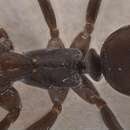Biology
provided by Arkive
The nest, which is small and conical in shape, is made from Sphagnum moss and grasses, and is typically located in wet boggy areas (4), often inside tussocks of purple moor grass (Molinia caerulea) (6). The nests often become saturated or submerged for short periods, despite being built above the water level of the bog (4). Nests typically contain a single queen and up to 1000 workers (4). In many species of ant, the pupae are surrounded by a cocoon in order to prevent desiccation; black bog ant pupae often lack cocoons, perhaps because the nest is so moist that desiccation is unlikely (4).
Conservation
provided by Arkive
The black bog ant is a UK Biodiversity Action Plan (UK BAP) priority species, and a Species Action Plan has been produced to coordinate its conservation. It is also included in English Nature's Species Recovery Programme, which has funded research into the species. Studies have investigated the effects of grazing on the black bog ant, in order to find the optimal grazing regimes to maintain populations of the ant (6).
Description
provided by Arkive
This rare, medium-sized ant is black and shiny (4).
Habitat
provided by Arkive
Usually found in lowland Sphagnum bogs; this species is typically found in the transitional zone where wet heath meets valley mire or bog (2).
Range
provided by Arkive
In the UK, this species has always been rare (5), records are restricted to sites in the New Forest in Hampshire, the Dorset heaths and a locality in south Wales (2); an old record from the Isle of Wight may be erroneous (3). Elsewhere, it is found from the Pyrenees, reaching east to Japan, and from the Apennines in the south to Arctic Sweden (4).
Status
provided by Arkive
Classified as Endangered in Great Britain (3).
Threats
provided by Arkive
Main threats to this species include the loss of boggy and wet habitats (4), particularly through drainage (5), resulting in the lowering of the water table and conditions becoming too dry for the ant (3). At sites where the water table is lowered, invasion of the habitat by trees and scrub will lead to the loss of black bog ant colonies; excessive year-round grazing by livestock also appears to be detrimental (2). Prolonged periods of drought, pollution of watercourses and regular heathland fires will result in the loss of colonies (2).

